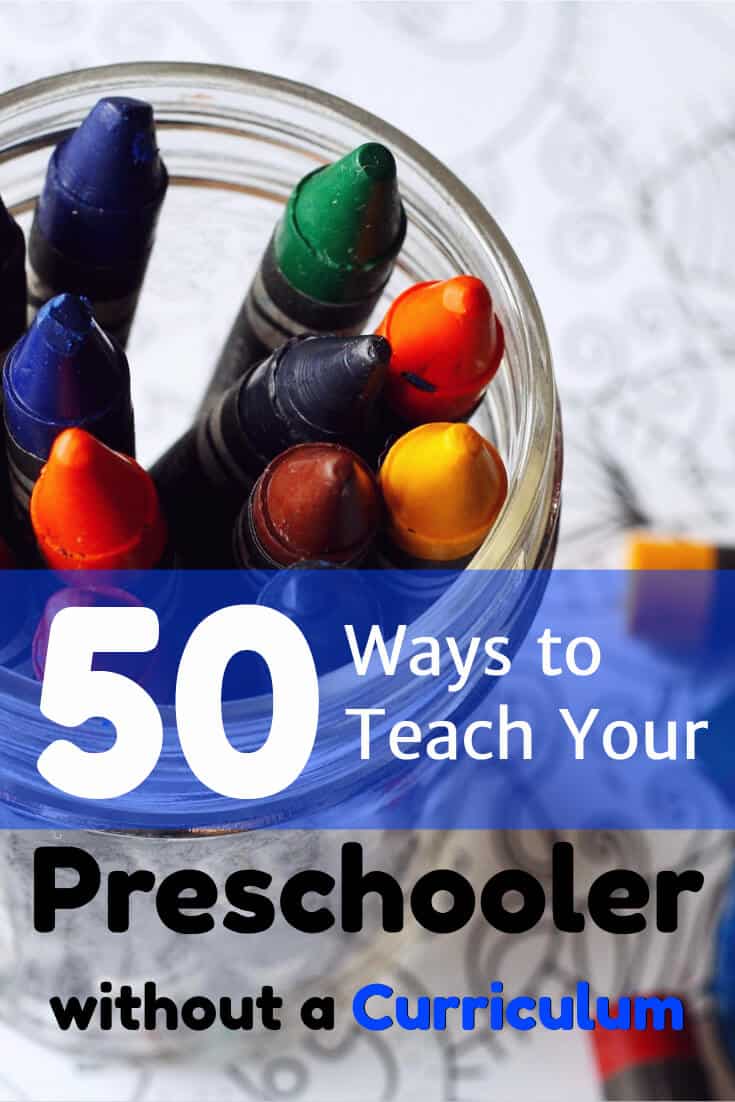50 Ways to Teach Your Preschooler without a Curriculum

During preschool, your child's brain grows explosively. Learning isn't limited to a few dedicated hours of curriculum-driven activity. Even play is learning. Watch for ways to help them learn all day long.
Alphabet Letters and Sounds
1. Form letters with playdough.
2. Sing the ABC song when you wash hands.
3. Play with foam or magnetic alphabet letters.
4. Point out alphabet letters: on food containers, books, at the store, on buildings and signs. Make their sounds.
5. Let your child write their own name on family greeting cards.
6. Help your child sign their artwork.
7. Read both familiar and new stories together. Follow the words with your finger. Ask questions. Take time to linger on each page.
8. Sing songs and recite nursery rhymes.
Colors, Shapes, and Objects
9. Name the colors of your child's clothes as they dress.
10. Line up stuffed animals by size. Start with just two or three.
11. Sort toys into colors.
12. When they’re waiting on the toilet, practice naming body parts: eyes, toes, knees.
13. Point out the colors of foods at meals.
14. Name the shapes at lunch: square cheese, triangle sandwiches, oval egg, etc.
15. Practice drawing and naming shapes. Draw them funny faces.
16. Name objects as you handle them throughout the day. Invite your child to repeat the word.
17. In a waiting room or standing in line, look around and find shapes.
18. When coloring, name each color.
19. Point out different colored vehicles on the road.
Time, Days, and Seasons
Even though preschoolers’ brains cannot yet grasp abstract concepts like time, you can begin introducing names and ideas.
20. Talk about when you do certain things: “Story time is at 10:00.” “Naptime is in the afternoon.” “Bedtime is at 7:30.”
21. Talk about things you did “yesterday,” “today,” and things happening “tomorrow.”
22. Tell your child what day it is, and what order: “Today is Tuesday. ‘Monday, Tuesday, Wednesday.’”
23. Talk about seasons, and changes in weather and activities.
24. Show your child calendars and clocks. Time them getting dressed or picking up.
Numbers and Counting
25. Write numbers on a page for your child to trace.
26. Count things out loud: fingers, toes, apple slices, people. Let them echo you.
27. Form numbers out of cookie dough.
28. Fill a cooking tray with salt, then draw and erase numbers in it.
Coloring and Cutting
Switch up your usual craft supplies to practice with various art mediums. Try:
29. Coloring books and crayons.
30. Markers and cardboard boxes.
31. Scissors and construction paper. (Help your child cut out their drawings, or practice on old magazines.)
32. Fancy-edged scissors.
33. Watercolors and paintbrushes.
34. Dry-erase markers.
35. Playdough.
36. Chalk on sidewalks or black paper.
37. Finger paints.
38. Glue or stick glue.
39. Glitter or glitter glue.
40. Pens and lined paper.
41. Pencils and eraser.
42. Colored pencils.
43. Patterned paper.
Socializing and Sharing
44. Join a homeschooling group with children your child’s age.
45. Decorate signs and charts of family expectations, rules, and consequences. Preschoolers thrive on routine and consistency.
46. Make and follow a "treasure map" to teach your child to follow simple directions.
47. Learn a few sign language signs to help children communicate their wants and needs. (This cuts down on tantrums for children who have difficulty articulating verbally.)
48. Use pretend scenarios to practice kindness, sharing, and forgiveness.
49. Learn to work together by baking, or helping set the table.
50. Learn to take turns using toys, simple games, or swings and slides at the park.







Leave a Reply